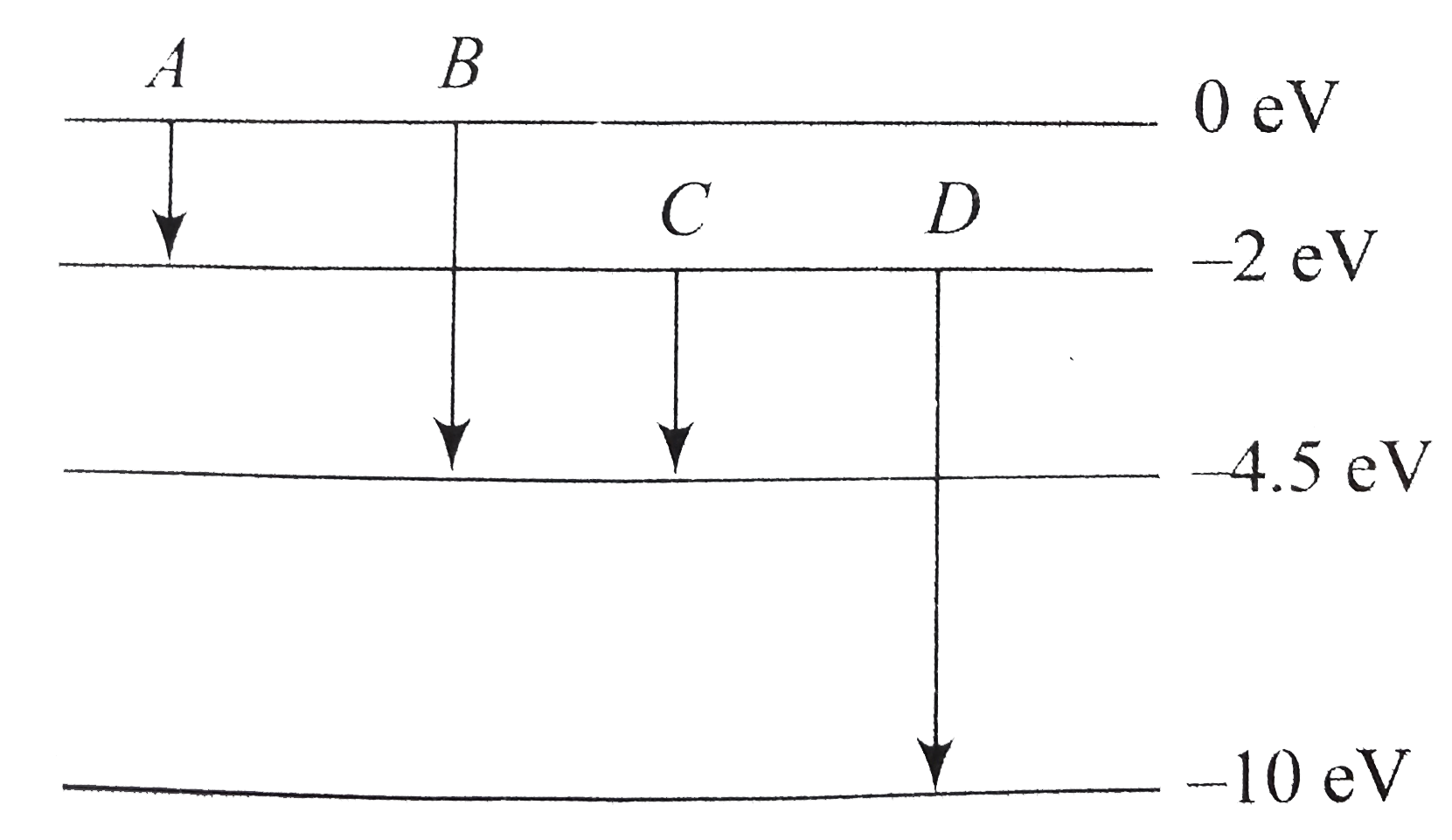Two hydrogen atom collide head on and end up with zero kinetic energy .Each atom then emit a photon of wavelength 121.6nm .Which transition leads to the wavelength ?
To determine which transition leads to the emission of a photon with a wavelength of 121.6 nm from hydrogen atoms, we can follow these steps:
Step 1: Understand the Problem
Two hydrogen atoms collide and end up with zero kinetic energy, which means all the kinetic energy is converted into potential energy, exciting the electrons in the hydrogen atoms. After the collision, each atom emits a photon of wavelength 121.6 nm.
Step 2: Use the Rydberg Formula
The Rydberg formula for the wavelength of emitted light during an electron transition in a hydrogen atom is given by:
1λ=RH⋅Z2(1n21−1n22)
Where:
- λ is the wavelength of the emitted photon.
- RH is the Rydberg constant (1.097×107m−1).
- Z is the atomic number (for hydrogen, Z=1).
- n1 and n2 are the principal quantum numbers of the lower and higher energy levels, respectively.
Step 3: Convert Wavelength to Meters
Convert the wavelength from nanometers to meters:
λ=121.6nm=121.6×10−9m
Step 4: Calculate the Rydberg Formula
Substituting the values into the Rydberg formula:
1121.6×10−9=1.097×107⋅(1n21−1n22)
Calculating the left side:
1121.6×10−9≈8.23×106m−1
Step 5: Set Up the Equation
Now we set up the equation:
8.23×106=1.097×107⋅(1n21−1n22)
Step 6: Solve for the Transition
Rearranging gives:
1n21−1n22=8.23×1061.097×107
Calculating the right side:
8.23×1061.097×107≈0.75
Step 7: Determine n1 and n2
We have:
1n21−1n22=0.75
Assuming n1=1 (ground state) and n2=2 (first excited state):
112−122=1−0.25=0.75
This confirms that the transition is from n2=2 to n1=1.
Conclusion
The transition that leads to the emission of a photon with a wavelength of 121.6 nm in hydrogen is from the second energy level (n=2) to the first energy level (n=1).
---
Two hydrogen atoms collide and end up with zero kinetic energy, which means all the kinetic energy is converted into potential energy, exciting the electrons in the hydrogen atoms. After the collision, each atom emits a photon of wavelength 121.6 nm.
The Rydberg formula for the wavelength of emitted light during an electron transition in a hydrogen atom is given by:
1λ=RH⋅Z2(1n21−1n22)
Where:
- λ is the wavelength of the emitted photon.
- RH is the Rydberg constant (1.097×107m−1).
- Z is the atomic number (for hydrogen, Z=1).
- n1 and n2 are the principal quantum numbers of the lower and higher energy levels, respectively.
Convert the wavelength from nanometers to meters:
λ=121.6nm=121.6×10−9m
Substituting the values into the Rydberg formula:
1121.6×10−9=1.097×107⋅(1n21−1n22)
Calculating the left side:
1121.6×10−9≈8.23×106m−1
Now we set up the equation:
8.23×106=1.097×107⋅(1n21−1n22)
Rearranging gives:
1n21−1n22=8.23×1061.097×107
Calculating the right side:
8.23×1061.097×107≈0.75
We have:
1n21−1n22=0.75
Assuming n1=1 (ground state) and n2=2 (first excited state):
112−122=1−0.25=0.75
This confirms that the transition is from n2=2 to n1=1.
The transition that leads to the emission of a photon with a wavelength of 121.6 nm in hydrogen is from the second energy level (n=2) to the first energy level (n=1).
Topper's Solved these Questions
- BOOK - CENGAGE CHEMISTRY ENGLISHCHAPTER - ATOMIC STRUCTUREEXERCISE - Exercises (Subjective)52videos
ATOMIC STRUCTURE
- BOOK - CENGAGE CHEMISTRY ENGLISHCHAPTER - ATOMIC STRUCTUREEXERCISE - Exercises Linked Comprehension50videos
ATOMIC STRUCTURE
- BOOK - CENGAGE CHEMISTRY ENGLISHCHAPTER - APPENDIX - INORGANIC VOLUME 1EXERCISE - chapter-7 Single correct answer1videos
APPENDIX - INORGANIC VOLUME 1
- BOOK - CENGAGE CHEMISTRY ENGLISHCHAPTER - CHEMICAL BONDING AND MOLECULAR STRUCTUREEXERCISE - Archives Subjective15videos
CHEMICAL BONDING AND MOLECULAR STRUCTURE
Similar Questions
Two hydrogen atoms undergo head on collision and end up with zero kinetic energy. Each particle then emits a photon of wavelength 1028 Å. Which transition leads to this wavelength ? Calculate the velocity of hydrogen atom before collision (mH=1.67×10−27kg)
View SolutionEnergy of an emitted photon with wavelength 620nm is :
View SolutionWhat will be the kinetic energy and total energy of an electron in H atom if the atom emit a photon of wavelength 4860Å ?
View SolutionA hydrogen atom emits ultraviolet of wavelength 102.5nm what are the quantum number of the state involved in the transition?
View Solution(a) An atom initally in an energy level with E = - 6.52 eV absorbs a photon that has wavelength 860 nm. What is the internal energy of the atom after it absorbs the photon?
(b) An atom initially in anergy level with E =-2.68 ev emits a photon that has wavelength 420 nm. What is the internal energy of the atom after it emits the photon?View SolutionIf a hydrogen atom at rest, emits a photon of wavelength λ, the recoil speed of the atom of mass m is given by :
View SolutionA hydrogen like atom in ground st6ate abserbs n photon having the same energy and its emit exacity n photon when electron transition tekes placed .Then the energy of the absorbed photon may be
View SolutionThe energy levels of an atom are as shown in figure . Which one of those transition will result in the emission of a photon of wavelength 275nm?
 View Solution
View Solutionin cases of hydrogen atom, whenever a photon is emitted in the Balmer series, (a)there is a probability emitting another photon in the Lyman series
(b) there is a probability of emitting another photon of wavelength 1213Å
(c ) the wavelength of radiaton emitted in Lyman series is always shorter then the wavelength emitted in the Balmer series
(d) All of the above.View Solution(a) A gas of hydrogen atoms is their ground state is bombarded by electrons with kinetic energy 12.5 ev. What emitted wavelengths would you expect to see?
(b) What if the electrons were replaced by photons of same anergy?.View Solution

